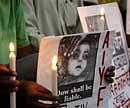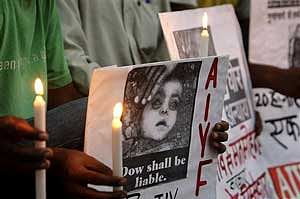

On December 3, 1984, the world's worst industrial catastrophe occurred due to the leak of Methyl isocyanate gas from the Union Carbide India Limited company (UCIL) in Bhopal.
Millions were left sick and the affected passed on the harmful effects of the gas to the next generations, making it the deadliest man-made environmental disaster in history.
The most recent such disaster is the Gulf of Mexico oil spill, which started in April following an explosion at the British Petroleum's Deepwater Horizon rigging well.
Although it claimed only 11 lives, its damage to the environment has been described as "catastrophic" as it has been spewing over 5,000 barrels a day from the seafloor.
If the well continues to flow unabated like this for two months until BP can cap it, the Deepwater Horizon spill could surpass the 1989 Exxon Valdez spill of 270,000 barrels as the biggest in US history.
Experts say the spill is now posing a serious threat to a range of marine animals from floating plankton to marine plants and animals living at the bottom of the sea.
What is common in the oil spill and Bhopal gas leak is that in both cases safety mechanisms that should have been rigorously tested were overlooked and additional safety mechanisms that should have been in place were not there primarily due to lax oversight, experts say.
Some experts also compare this accident with the 1986 Chernobyl nuclear plant mishap that took place during a safety test in the plant in Ukraine (then in the Soviet Union).
An explosion at the core of a nuclear reactor at the Chernobyl power station at Prypriat on April 26, 1986 released more than 50 tonnes of radioactive material into the atmosphere. About 59 people died at the accident site while more than 4,000 people died of cancer and thousands rendered disabled over the years due to of radiation exposure.
Following the blast, about 350,000 people were evacuated from the area, and Prypriat still remains a ghost town.
Besides these incidents, there are a number of industrial accidents that had caused huge loss of lives and damage to the environment.
In September 1921, an explosion at a fertiliser plant in Oppau, Germany, killed nearly 600 people and injured more than 2,000. The incident, known as 'Oppau Explosion', occurred when a tower silo storing 4,500 tonnes of a mixture of ammonium sulfate and ammonium nitrate fertiliser exploded.
In mid-1950s, the world came to know about an industrial pollution known as 'the Minamata disaster', effects of which came to light more than three decades after the incident.
The disturbing story began in the 1930s when a Japanese company started dumping of mercury compounds in the bay off Minamata, a western Japan town.
But only after three decades, locals began to notice something wrong. They found themselves being affected by a strange illness which came to be known as Minamata disease.
It is estimated that over 3,000 people suffered various deformities, showed severe mercury poisoning symptoms or died from the mysterious disease.
In April 1942, China witnessed one of its worst disasters when a blast at a coal mine, Honkeiko, at Benxi in Liaoning province claimed lives of 1,549 miners.
In December 1952, a dense acid-infused smog shrouded London and brought the city to a standstill for four days.
According to official estimate, more than 4,000 people died from the immediate effects of the toxic air on their respiratory system, while 8,000 additional deaths were later attributed to the smog.
Sulfur dioxide in the air was believed to be the main culprit. The main pollutants were believed to be by-products of coal burning which was said to have reached "exceptional levels".
In April 1947, an explosion aboard a docked ship loaded with 3,200 tons of ammonium nitrate fertiliser in Texas City killed at least 578 people and injured 3,500. The aid ship was meant for farmers of Europe recovering from World War II.
In July 1976, an accident at a chemical plant in Italy's Seveso town released toxic dioxins into the atmosphere, killing thousands of animals. It also led to culling of about 70,000 animals to prevent dioxins from entering food chain.
A recent study published in journal 'Environmental Health' found that people living in the Seveso area have experienced an increased risk of developing cancer.
There were also several oil spills that sparked environment concerns in the latter half of the past century.
The incidents included the 1979 blowout of an undersea oil well off the Gulf of Mexico, 1988 Shell Oil refinery explosion in Louisiana and the explosion on a North Sea oil production platform in Britain the same year.
The latter, known as Piper Alpha disaster in which 167 people were killed, is still rated as the world's worst offshore oil disaster in terms both of lives lost and impact to industry.
There have also been scores of nuclear accidents, including the 1957 Kyshtym disaster in Mayak, Russia and the explosion in Russian nuclear submarine Kursk that killed all 118 crewmen on board in August 2000.
The blast was estimated to be equivalent to about 1-2 kilotonnes of TNT and was heard as a loud bang in Munich, over 300 km away. The pressure wave ripped off roofs up to 25 km away and damaged windows even farther away.